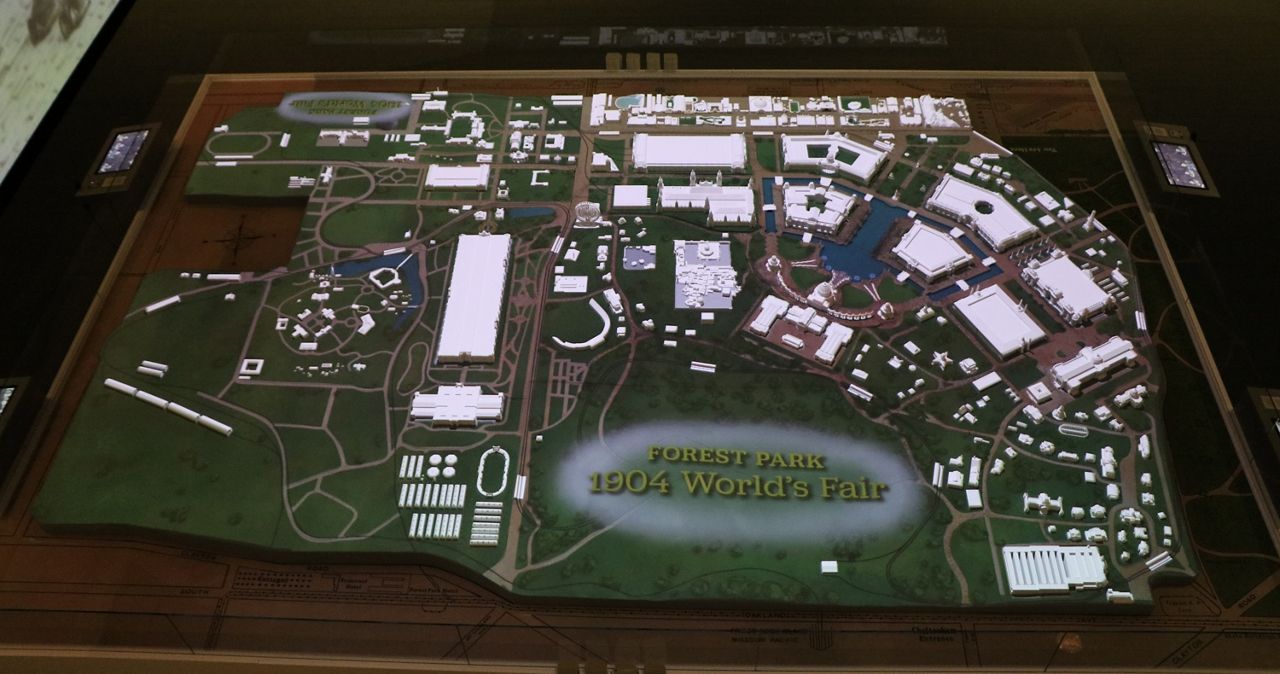ST. LOUIS — Relive the wonder and the complexities of the 1904 World’s Fair in the brand new exhibit at the Missouri History Museum slated to open later this month.
Approximately 20 million visitors from around the world attended the 1904 World’s Fair in Forest Park roughly 120 years ago.
The new exhibit features more than 200 artifacts, such as ruby glass that people bought as souvenirs, construction equipment used to build the Fair, the desk of the president of the Fair and more, according to Adam Kloppe, Missouri History Museum historian.
It also includes hundreds of photos, original artwork and historical commentary from partners across the St. Louis community.
The center of the exhibit is a 1:400 scale model of the 1904 World’s Fair fairgrounds that shows visitors the enormity of the 1,200-acre exhibition. Historians and PGAV Destinations’ team collaborated to build each element of the model with detail and historical accuracy.
“The centerpiece of this exhibit is a huge scale model that’s going to show every building, every pathway, everything that was at the 1904 World’s Fair, so you can get a sense of the scale and the scope of that event for yourself,” Kloppe said.
Above the scale model, a projection screen displays a series of 120 photographs commemorating the years since the Fair, and shows the buildings and the people who attended, and those who were put on display there.
“We’ve had World’s Fair exhibits up in the past, but this is frankly the best exhibit we’ve ever done about the 1904 World’s Fair,” Kloppe said.
One of Kloppe’s favorite artifacts in the exhibit is a silver medal from the 1904 Olympics, which were part of the World’s Fair.
“It’s a medal for the tug-of-war event, which doesn’t really sound like an Olympic event (in) the style that we might see today. It was an Olympic event in several of the early 20th century Olympics,” Kloppe said.
He added that those artifacts “remind us of just what a different time this was for an event like the Olympics and that’s, I think, a really cherished artifact.”
New exhibits will open in the space every other year, including exhibits about the Fair’s Ferris Wheel and the 1904 Olympics that were held on what is now Washington University, according to Kloppe.
“History is often told through stories illustrated in museums buy artifacts, archival documents, and photographs,” said Sharon Smith, Missouri History Museum curator of Civic and Personal Identity.
“The new exhibit’s artifacts and stories will help visitors see the event for all that it was: an amusement park, a laboratory, a workplace, a stadium and a place where America’s imperial ambitions were on display for the world to see.”
The new exhibit also highlights stories from a broad range of voices and perspectives on America’s central inequalities and spectacles of colonialism, including controversial displays at the Fair and who were allowed to attend.
“We also want folks to examine the complexity of the 1904 World’s Fair to talk about some of the really complicated and messy historical narratives that are part of this event,” Kloppe said.
Visitors will learn about stories of more than 1,000 Filipinos who were brought to live on the Philippine Reservation at the fairgrounds, just six years after America’s colonization of the Philippines.
Their lives and bodies were on display for the amusement of fair-goers, according to Kloppe.
When Filipino-American Ria Unson moved to St. Louis, she learned that her great-grandfather served as a waiter and a guide on the Philippine Reservation during the Fair.
Now, her original artwork and family’s story is on display in the exhibit.
“Her art talks a lot about the complicated legacy that’s left for herself, for her family, for her sense of history here in St. Louis,” Kloppe said.
The grand opening of the new exhibit is Saturday, April 27, with festivities beginning at 9:30 a.m. with a parade. In the afternoon, guests can learn about African Dance and a Japan American Tea Ceremony at the exhibit. Sunday will feature Chinese lessons.
Horse drawn carriage rides and pedicab rides around Forest Park will be available throughout that weekend, in addition to performances by the Confluence Chamber Orchestra, food trucks and performers from Circus Flora.
For more information about the grand opening ceremonies, visit the Missouri History Museum’s website.



